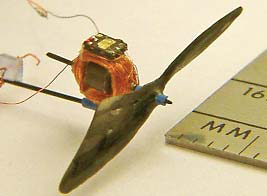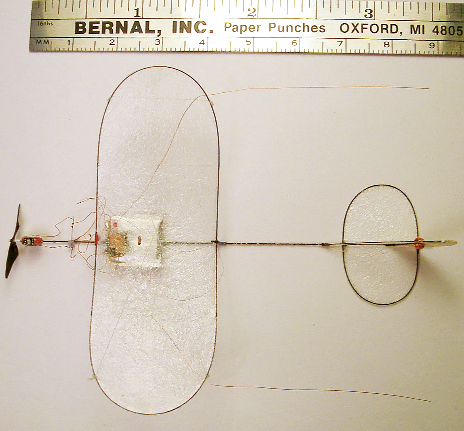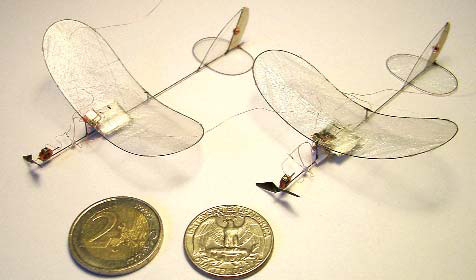Breaking The 1/2-gram Barrier Twice
 |
|
 Regular Fly RC readers will recall the microflight milestones achieved by Martin Newell of San Jose, CA. We reported in the February 2006 issue that Martin was the first to break the 1-gram barrier for an electric radio-control model. At the 2006 NEAT Fair, Martin was at it again with his .695-gram models; the first under 700 milligrams. As you can see, Martin is not one to stop once he has achieved a goal. Driving onward, he continued to optimize every component to reduce the weight even further. A few weeks ago, Martin ducked under another barrier that few thought could be breached. His latest model, the Shark, tips the scales at less than 1/2 gram or, more precisely, 495 milligrams (mg). He has two versions of the Shark, and the lighter one weighs only 485mg. In addition to their sub-1/2-gram weights, the two models feature other unique innovations. Both feature single-phase brushless motors that Martin hand-built. They consist of a single coil with a magnet mounted on a .010 carbon-fiber prop shaft running in stainless- steel hypodermic bearings. The motor is controlled by the tiny Allegro 1442 chip. Martin forms propellers of his own design out of lightweight carbon fiber and epoxy over Delrin forms he machines with a CNC-equipped Sherline mill.
|
|
How much is 1 gram?For most people, a gram is a rather hazy measure, too small to be of much practical use and well below the radar in day-to-day life. Consider these examples. A U.S. dollar bill weighs 1 gram and a regular-size Kleenex tissue about 1.4 grams. Thus, 1/2 gram is equal in weight to half a dollar bill or about one third of a tissue. |
SPECSMODEL: Shark WINGSPAN: 2.65 in. WING AREA: 2.84 sq. in. WEIGHT: 485 – 495mg (.0171 – .0175oz.) WING LOADING: .87 – .89 oz./sq. ft. LENGTH: 3.3 in. POWER SYSTEM: 45mg singlephase 35-ohm handmade brushless motor, custom carbon-fiber prop, Allegro 1442 controller, Atomic Workshop 8.5mAh LiPo battery FULL-THROTTLE POWER: .075 amps, .27 watts, 14.2 W/oz., 227 W/lb. TOP RPM: 25,200 STATIC THRUST: 195mg DURATION: 1 min. 40 sec. ACTUATOR: 1/16-in. (1.6mm) ID, 135 ohms, 1×0.5mm magnet AIRFRAME: .010 CF rod fuselage, .007 CF rod wing and tail outlines MINIMUM FLYING AREA: 20-ft. sq. WEIGHT BREAKDOWN PROP 15mg MOTOR 45mg BATTERY 295mg RECEIVER 60mg AIRFRAME, SWITCH, ACTUATOR 60mg WIRE 10mg |
| F-86 SABREThe North American F-86 Sabre was the U.S. Air Force’s first sweptwing jet fighter, its last true “dogfighter” and one of the most successful warbirds in military aviation history. It first flew in 1947 and became operational with the Air Force in 1948, and by the time its last squadron was retired in Portugal in 1980, almost 10,000 aircraft in 20 variants had been produced, and it had flown in the air forces of 24 countries. The F-86 benefited from German World War II jet fighter development. The Sabre incorporated many technological and design innovations. It was the first jet to have a sweptwing configuration. It was the first to feature a “flying tail” that enables it to maneuver at high altitudes. It also incorporated full-span leading-edge slats to prevent pitch-up. The F-86’s identifying feature was its nose: an open nose inlet that delivered air to the turbojet engine behind the pilot.
EDITOR’S COMMENTS The judges at the 2007 WRAM show in February justly awarded this model first place in Electric Scale, where I was honored to see it. In midsummer, I had the pleasure of getting together with Rob Caso again and actually flying his incredible creation. I was anxious, but Rob’s Bulldog is surprisingly well behaved even though it retains the speed and agility expected of a Golden Age racer.
|
|
 Fly RC Magazine WE LIVE RC
Fly RC Magazine WE LIVE RC

